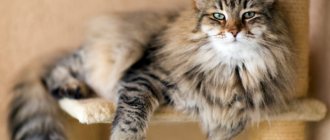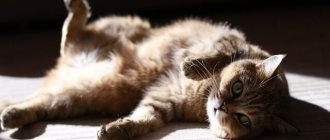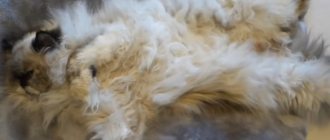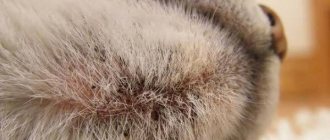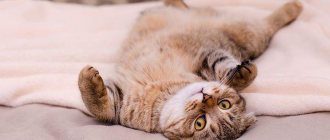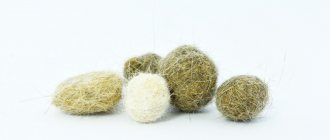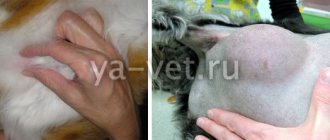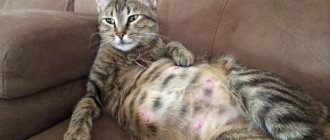We all know how soft cat fur feels under our fingertips and how impeccable their hygiene is. However, as a cat owner, I am accustomed to ailments that most cats have to contend with at least once in their lives. More importantly, I know that some of them may be a sign of a larger problem. So, when I noticed an excessive amount of loose hair around my house, the only question I thought was - why does my cat's hair fall out in clumps?
Some may think that hair loss in cats is quite common. We've all seen how much hair is left on our clothes when a feline leaves our lap after a short cuddle session. However, if the fur is falling out in clumps, it may be a sign that your cat needs to be taken to the vet.
About feline alopecia
Due to stress or some other factors, hair may begin to fall out in clumps, leaving a receding hairline all over.
The same thing can happen with cats. Alopecia in cats is a fairly common problem and comes in several forms. It can be partial or complete, and the cat can lose hair symmetrically or in a completely random pattern.
The problem is that hair loss in cats can be caused by almost anything. Some triggers require careful testing, especially since some cats may be born with it.
© shutterstock
Symptoms
A healthy cat's fur is smooth, shiny, firmly held in the skin, and the coat itself is not ruffled.
With the development of alopecia, areas of baldness can be complete or partial, located symmetrically or not. In some cases, the animal may scratch these areas, and the skin here may be hot and red.
Rice. 2. Partial alopecia on the back of a cat.
In skin diseases or behavioral disorders, alopecia is symmetrical on the trunk, forelimbs, thighs, sides or abdomen. The age and gender of the animal do not matter.
When stress occurs, hairs broken and torn out by the cat itself are found in the back, on the limbs, stomach and inner thighs, near the genitals and anus. Cats of “nervous” breeds are especially susceptible: Siamese, Burmesse, Himalayan and Abyssinian. These breeds will have darker hair color after restoration.
In case of hormonal imbalances, alopecia is observed in the area of the bridge of the nose, croup, base of the tail, hips, and chest. The skin loses its elasticity.
And if there is a lack of thyroid hormones in a cat, hair in the area of the pelvic bones is easily pulled out by the roots. Such alopecia, including asymmetrical ones, are recorded on the abdomen, chest and neck. The cover is restored with difficulty.
With malignant tumors, there is a complete absence of hair shafts on the abdomen, alopecia quickly spreads to the chest and limbs, and then can affect the entire surface of the skin. At the same time, the skin on the affected areas shines.
With vitamin deficiency A, alopecia areata develops: spots without hair, round in shape, form on the skin, which merge to form large alopecias. The skin has a bright pink color.
With microscopic fungi (trichopytosis, microsporia), hairless areas of the skin are reddened and may have scales and crusts, scabs and wounds.
With scabies, redness, itching, and in particularly advanced cases, purulent inflammation of the skin are observed. Dermatitis is accompanied by an increase in local body temperature, scratching, the appearance of pimples, etc.
If the course of alopecia is unfavorable, an infection may occur, and then an inflammatory process develops on the skin.
Fleas
Owning a dog and a cat, or living in an area where the cat has easy access to the outdoors, may be the reason your feline suddenly loses its fur in clumps. If a cat is able to go outside and socialize in nature or is in close contact with a dog every day, he may be bitten by a flea.
Now the cat can avoid losing hair because of the fleas themselves. The cause of baldness in this case is an allergy to flea bites. If a feline is sensitive to flea saliva, it may develop alopecia, especially in the hindquarters.
Unfortunately, it only takes one flea to cause a rather unpleasant and sometimes long-lasting reaction. This is why it is important to take your cat to the vet immediately to avoid further damage to the skin and fur.
Luckily, this condition is easy to treat with some flea treatments and shampoo. If the itching persists and hair loss is excessive, your veterinarian may also prescribe antihistamines or corticosteroids.
The cat's hair is falling out: what to do if this is not a clinical case
If a cat loses hair due to natural reasons (for example, shedding), the following measures should be taken:
- comb out excess hairs daily using a sparse comb;
- provide the animal with a comfortable temperature regime, preventing overheating of the body;
- use combs and combs for hair care in accordance with the type of coat;
- For bathing, use only special detergents intended for animals.
Ticks
However, it's not just fleas that cat owners have to worry about. Mites are common on most mammals and when their populations increase dramatically, they can cause severe itching, skin lesions, and hair loss in clumps, among other things.
Mite infestations usually occur when a cat's immune system is not functioning properly. Because of this, it is not uncommon for stressed cats or felines to already have some other disease. Additionally, if hormone levels rise or the cat begins to produce excess oil, a common consequence is an outbreak of Demodex mites, and the end result is a condition called mange.
In most cases, mite infestations are evident around the cat's eyelids, flanks, head and neck. In addition to missing hairballs, his skin will also be scaly, with lesions and scabs.
To confirm the presence and determine the type of mite causing the problem, the veterinarian will scrape the skin. Sometimes hair analysis can also help in identification. You may also need to do a urine test to rule out other conditions with similar symptoms.
The good news is that in 90% of cases, demodectic scabies goes away on its own with time. However, if it is severe, long-term medications and lime-sulfur sauces may be needed to control the condition and help the cat recover.
Fungal infection (ringworm)
Although there is a “worm” in this disease, it is actually a fungal infection that can be easily transmitted to people. Cats usually become ill from contact with other infected animals. From there, the infection spreads and can wreak havoc on your home, whether you have a cat or a kitten.
Hair loss in clumps is the most common symptom. A ringworm infection causes the hair to become quite brittle so it breaks, leaving behind clumps. The areas most commonly affected are around the feet, ears and face.
The skin will also show signs of infection; The ears, feet and parts of the face may appear slightly reddish, and there may also be white or gray crusts. In general, hairless skin will appear dry and flaky.
Looking for an answer to the question, why does my cat's fur fall out in clumps? this infection seemed like the biggest red flag to me. Since my cat was leaving clumps of fur behind her and some of the hairless parts were quite dry to the touch, I had to confirm the diagnosis with a vet.
Fortunately, the cat recovered quickly. To confirm the infection, the veterinarian tested a fungal skin culture. Treatment included the use of various antifungal agents such as shampoos, sprays and creams. Treatment may also include oral medications, but they were not necessary in our case.
The cat is losing hair: what will the veterinarian prescribe?
In a situation where a cat is losing hair, a veterinarian will prescribe treatment depending on the root cause:
- for fungal infections, local anti-inflammatory drugs are used - Mycozon, Fungin, Exoderil;
- Special shampoos are effective for trichophytosis;
- oral agents, for example Intraconazole, Griseovulfine, are used only on the recommendation of a veterinary specialist;
- if alopecia is caused by nutritional deficiency, then the animal is prescribed vitamin preparations and dietary supplements;
- Pyoderma will require complex treatment - a sick cat is prescribed not only local antibacterial agents, but also antibiotics in the form of injections.
Allergies
If a cat is allergic to dust or pollen, something in her food, or certain medications, her body will begin to itch, causing her to groom herself excessively to soothe herself. This can cause the fur to fall out in clumps as the cat licks the fur until a bald patch remains.
Common allergens include beef, dairy and fish. To make sure your cat food is no longer suitable, you can try switching to other brands for a while. Additionally, environmental allergies, such as mold spores and grass, can also cause atopic dermatitis to:
- Armpits
- Wrists and ankles
- Groin
- Around the eyes and between the toes
- Around the muzzle and ears
To confirm an allergy, the veterinarian will examine the cat and its entire medical history. Sometimes a serological allergy test and intradermal testing can help determine the cause.
However, treatment depends on the allergen and sensitivity level. If your cat is hypersensitive, desensitizing therapy may help. On the other hand, to relieve itching, your veterinarian may prescribe anti-itch sprays, antihistamines and corticosteroids, as well as cyclosporine (for long-term allergies).
Hair loss in cats: causes and treatment
Treatment for hair loss in cats depends on the underlying cause of the symptom.
| Cause of baldness | Therapeutic measures |
| Trichophytosis | Antiseptic solutions, antifungal drugs, immunomodulators, vaccination with Microderm, Vakderm vaccines. |
| Pyoderma | Antiseptics, anti-inflammatory drugs, broad-spectrum antibiotics. |
| Avitaminosis | Multivitamin and mineral supplements. |
| Ear mite | Antiparasitic ointments, sprays, creams. |
| Allergy | Adjustment of diet, hypoallergenic food, antihistamines. |
| Flea dermatitis | Antiparasitic shampoos, antiseptics, anti-inflammatory ointments that reduce itching. |
Psychogenic alopecia
Another form of alopecia that many cat owners don't consider at first is psychogenic alopecia, which causes the cat to pull out and chew its own hair due to anxiety, stress or fear. However, since cats like their daily routine and do not adapt to new people and environments easily, this form of alopecia is quite common.
The main problem here is the cat's behavior because she uses grooming as a way to relax. When it is exposed to too much stress, it can develop into over-grooming, causing the cat to lick fur until it becomes hairless.
The best way to manage this form of alopecia is to take better care of your cat. It is extremely important not to put too much (unnecessary) stress on her and to maintain a consistent daily routine. However, in more severe cases, anti-anxiety medications can also be used.
© shutterstock
Hormonal imbalance
Now, when looking for an answer to the question of why is my cat losing hair in clumps, don't be surprised if you see hyperthyroidism on the list of common causes. When a cat suffers from overproduction of T4, its coat will often appear unkempt and greasy, with small bald patches here and there.
This is just one symptom of an overactive thyroid. To diagnose the disease, a veterinarian must not only check hormone levels, but also rule out kidney failure and diabetes. Both of these conditions have common symptoms.
On the other hand, a cat may be suffering from a hormonal imbalance unrelated to its thyroid gland. Its steroid levels can be high, causing hair follicles to die, often symmetrically. One of the most common causes of this is Cushing's disease, a metabolic disorder that can be quite difficult to diagnose. It shares many of the same symptoms as diabetes, but can also lead to hair loss and thin, fragile skin.
In both cases, medications and surgery are possible. If it is hyperthyroidism, the cat may also be given radioactive iodine therapy.
Poor nutrition
Finally, poor diet may be the problem. Today's commercial pet food is full of fillers that "bulk" the final product but have virtually no nutritional value. Because of this, a cat's fur often suffers when it eats low-quality food. The cat is not getting enough nutrients to support it!
However, as bad as it may sound, hair loss in clumps is reversible. You will have to switch to a healthier brand of cat food. The fewer fillers, the better; in any case, they do nothing for the cat's health and may reduce its quality of life. You may also consider adding powdered vitamins to your food to boost its nutritional value.
But in some cases, food may not be to blame either. If an underlying medical condition is preventing your cat from absorbing nutrients, this will need to be addressed by a veterinarian first.
Article by: Michael Grover I have been a pet owner most of my life. Now I'm retired and spend my days writing about problems related to cats and dogs. I am passionate about ending animal cruelty in any form. My passion is helping people like you identify behavioral problems in cats.
How to understand that this is a normal shedding
If the cat is cheerful and active, and its fur is smooth and shiny, but remains in clumps on furniture and other surfaces, most likely this is normal shedding. Shedding is a completely natural period in a cat's life. In an adult animal, it lasts from several weeks to two months, but the first molt can last for a whole year.
You can tell that a cat is shedding normally by the following signs:
- wet nose;
- ears and paw pads are warm, but not hot;
- appetite is not impaired;
- the cat does not itch or chew its fur;
- Bald spots do not form on the animal's body.
Shedding is a natural process in cats
Adult cats that live outdoors usually shed twice a year, in spring and fall. Cats that do not leave the apartment all year round practically do not feel the change of seasons, so molting may become blurred for them. Increased dryness of the air, especially if the cat likes to lie on hot radiators in winter, can prolong the molting process up to three months, so you need to humidify the room.
At the age of 5-8 months, the kitten begins to change from baby fluff to adult fur, and the color may noticeably change. At this time, the baby especially needs care and healthy nutrition.
Of all the cat breeds, only completely hairless Sphynxes never shed. In other cases, molting occurs one way or another. Cats with a dense undercoat shed more often and more intensely - British, Siberian, Persian and Maine Coons. Fluffy cats, for example, Burmese, Angora, Somali, have less dense undercoat, although they grow large collars by winter. Bengal, Siamese, Abyssinian, and Singaporean breeds shed moderately - they have almost no undercoat. In the usual sense, cats of such breeds as Devon Rex, Cornish Rex and La Perm, as well as overgrown Sphynxes, do not shed. Only a few times during their lives they shed, up to the formation of bald spots, changing their fur completely. However, some of them are prone to traditional seasonal molting.
